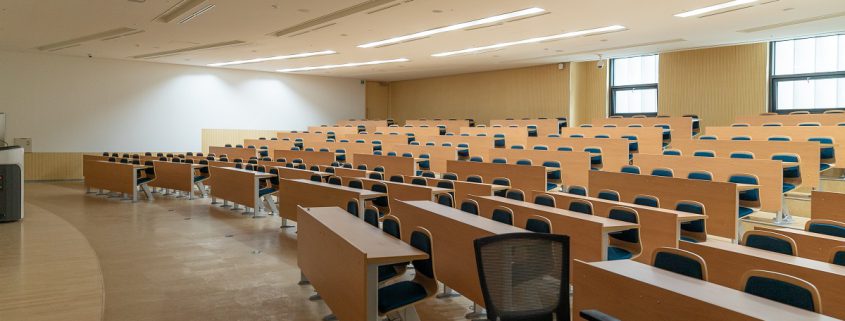What Are the Most Dangerous Activities on Campus?
You’re eager to get back to campus, or to have your sons or daughters do so. But do you know which campus activities on are the most likely to expose campus residents to the coronavirus?
We thought we knew. But apparently, we did not know everything. When we reviewed “Coronavirus Disease 19: vid Considerations for Institutions of Higher Education,” a list of campus danger spots and activities that was recently published online by the U.S. Centers for Disease Control and Prevention, we found some surprises. Because we want you and your students to be safe on college campuses, we recommend you this advisory.
Here are some of the campus activities the CDC lists.
Highest Risk
- Irregularly scheduled cleaning and disinfection of frequently touched areas
- Students and faculty freely share objects.
- Students and faculty regularly engage in in-person learning, activities, and events.
- Students, faculty, and staff attend large out-of-class social gatherings and events.
- Students, faculty, and staff dine in indoor dining rooms without social distancing.
- Students, faculty, and staff do not/are not required to follow steps such as proper use of face masks, social distancing, hand hygiene.
- Use of public buses, campus buses/shuttles or other high occupancy enclosed vehicles with limited ventilation and/or that require students, faculty, or staff to have sustained close contract with others.
Higher Risk
- Students and faculty engage in in-person only learning, activities, and events.
- Students and faculty share some objects (e.g., sharing of objects is limited to one group of students at a time for laboratory, art, or recreational equipment and supplies that cannot be purchased or assigned individually and that are wiped down with disinfectant, as possible, between uses).
Medium Risk
- Students, faculty, and staff follow all steps to protect themselves and others, such as proper use of face masks, social distancing, and hand hygiene.
- Hybrid learning model: Students participate in a mix of virtual learning and in-person learning for all courses (in-person learning is not limited to specific courses).
- Students, faculty, and staff participate in larger in-person classes, activities, and events that allow people to remain spaced at least six feet apart (in a classroom with marked seating or seating removed to encourage sitting six feet apart).
- Apply cohorting, alternating schedules, and staggered schedules with some exceptions in residence halls, dining areas, and recreational areas on campus.
- Students, faculty, and staff participate in limited, small out-of-class social gatherings and events.
- Students, faculty, and staff dine outside whenever possible, or in well ventilated rooms with social distancing applied.
- Students and faculty share objects minimally (e.g., sharing of objects is limited to one person at a time for laboratory, art, or recreational equipment and supplies that cannot be purchased or assigned individually and that are wiped down with disinfectant, as possible, between uses).
- Regularly scheduled cleaning and disinfection of frequently touched areas occur as planned with few exceptions.
- Students, faculty, and staff attend small out-of-class social gatherings and events.
- Students, faculty, and staff dine in indoor dining rooms, even while maintaining social distancing.
- Students, faculty, and staff follow only some steps to protect themselves at all times such as proper use of face masks, social distancing, and hand hygiene.
Some Risk
- Apply and support strict adherence to cohorting, alternating schedules, and staggered schedules in residence halls, dining areas, and recreational areas on campus to create small groups of students and minimize their contact with others (e.g., small cohorts of freshmen who live and learn together).
- Hybrid learning model: Students participate in virtual learning, and in-person learning is limited to courses and laboratory instruction that cannot be delivered remotely.
- Regularly scheduled (e.g., at least daily or between uses) cleaning and disinfection of frequently touched areas occur as planned (i.e., on-time and consistently).
- Students avoid out-of-class social gatherings and events and communications and policies discouraged these activities.
- Students, faculty, and staff do not share objects (e.g., laboratory, art, or recreational equipment and supplies).
- Students, faculty, and staff follow all steps to protect themselves and other at all times, including proper use of face masks, social distancing, and hand hygiene.
- Students, faculty, and staff participate in small, in-person classes, activities, and events that allow individuals to remain spaced at least six feet apart (e.g., lecture room with individual seating spaced six feet apart).
Lowest Risk
- Faculty and students engage in virtual-only learning options, activities, and events.
And Prevention Strategies Should Include
- Daily review of official public health data for the community surrounding the institution of higher education, to keep track of the current state of COVID-19 spread.
- Development of information-sharing systems with school and community partners. Institutional information systems can be used for day-to-day reporting on number of cases and information, such as absenteeism or changes in student and staff health center traffic to detect and respond to an outbreak.
We Invite You to Explore Your College & Career Options with Us. . .
Participate in the National Career & College Pathway Study to gain new insights about making educational decisions that align with your interests, passions, and aptitudes. Participants will receive information on college and career opportunities that match their interests.
Related Posts
Going Back to Campus? Consider these Safer Alternatives to Living in a Dorm
It’s Time to Have the Hard Conversation with Your Kids Who Are Heading to Campus
America’s Teachers Face Harder Decisions about Returning to School
What Kind of Coronavirus Testing Will Your College Be Giving Returning Students in the Fall?
Which College Majors and Careers Should You Consider if Most of Your Classes Will Be Taken Online?
How to Help Kids Stay Happy During a Time of Social Distancing
Resistance to Returning to Public Schools this Fall Is Running High










Leave a Reply
Want to join the discussion?Feel free to contribute!